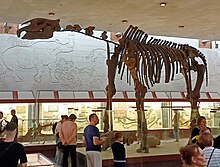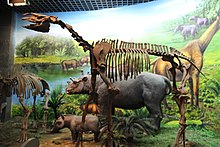Paraceratheriidae is an extinct family of long-limbed, hornless rhinocerotoids, native to Asia and Eastern Europe[3] that originated in the Eocene epoch and lived until the end of the Oligocene. They represent some of the largest terrestrial mammals to have ever lived.
| Paraceratheriidae Temporal range: Middle Eocene to Late Oligocene,
| |
|---|---|

| |
| Skeleton of Paraceratherium | |

| |
| Skeleton of Juxia | |
| Scientific classification | |
| Domain: | Eukaryota |
| Kingdom: | Animalia |
| Phylum: | Chordata |
| Class: | Mammalia |
| Order: | Perissodactyla |
| Superfamily: | Rhinocerotoidea |
| Family: | †Paraceratheriidae Osborn, 1923 |
| Subgroups | |
| |
| Synonyms[1] | |
Description
editThe necks and limbs of paraceratheriids are elongate relative to those of living rhinoceroses.[4] The earliest paraceratheres like Juxia were comparable in size with living rhinoceroses with a body mass of three quarters to one and a half tons, while later members grew substantially larger, with the largest representatives (Paraceratherium, Dzungariotherium) estimated to have a body mass of 17 to possibly over 20 tonnes, making them the largest land mammals to have ever lived (though possibly equalled or exceeded by some proboscideans in body mass).[5][6] Non-fostercoopine paraceratheriids are united by the possession of a retracted nasal notch, a lack of contact between the premaxilla and nasal bones of the skull, enlarged upper and lower first incisors and small lower canine teeth, along with characters relating to the size and shape of the molars and premolars.[3]
Range
editTheir range spanned from Eastern Europe in the west, the Indian subcontinent in the south, to Northern China in the east.[3]
Ecology
editParaceratheriids are thought to have been primarily browsers.[7]
Taxonomy
editAlthough considered a subfamily of the family Hyracodontidae by some authors, recent authors treat the paraceratheres as a distinct family, Paraceratheriidae (Wang et al. 2016 recover hyracodonts as more basal than paraceratheres).[8][9] Some authors choose to include the small, primitive fosterocoopines (Forstercooperia, Pappaceras) within the family,[10] while they are excluded by other authors.[3]
References
edit- ^ Lucas, S.G.; Sobus, J.C. (1989). "The Systematics of Indricotheres". In Prothero, D. R.; Schoch, R. M. (eds.). The Evolution of Perissodactyls. New York, New York & Oxford, England: Oxford University Press. pp. 358–378. ISBN 978-0-19-506039-3. OCLC 19268080.
- ^ Wood, H.E. (1963). "A Primitive Rhinoceros from the Late Eocene of Mongolia". American Museum Novitates (2146): 1–12.
- ^ a b c d Deng, Tao; Lu, Xiaokang; Wang, Shiqi; Flynn, Lawrence J.; Sun, Danhui; He, Wen; Chen, Shanqin (2021-06-17). "An Oligocene giant rhino provides insights into Paraceratherium evolution". Communications Biology. 4 (1): 639. doi:10.1038/s42003-021-02170-6. ISSN 2399-3642. PMC 8211792. PMID 34140631.
- ^ Hutchinson, John R. (2021-06-01). "The evolutionary biomechanics of locomotor function in giant land animals". Journal of Experimental Biology. 224 (11). doi:10.1242/jeb.217463. ISSN 0022-0949. PMC 8214834. PMID 34100541.
- ^ Larramendi, A. (2016). "Shoulder height, body mass and shape of proboscideans" (PDF). Acta Palaeontologica Polonica. 61. doi:10.4202/app.00136.2014.
- ^ Li, Shijie; Jiangzuo, Qigao; Deng, Tao (2022-07-06). "Body mass of the giant rhinos (Paraceratheriinae, Mammalia) and its tendency in evolution". Historical Biology: 1–12. doi:10.1080/08912963.2022.2095908. ISSN 0891-2963. S2CID 250366746.
- ^ Martin, C.; Bentaleb, I.; Antoine, P. -O. (2011). "Pakistan mammal tooth stable isotopes show paleoclimatic and paleoenvironmental changes since the early Oligocene". Palaeogeography, Palaeoclimatology, Palaeoecology. 311 (1–2): 19–29. Bibcode:2011PPP...311...19M. doi:10.1016/j.palaeo.2011.07.010.
- ^ Z. Qiu and B. Wang. 2007. Paracerathere Fossils of China. Palaeontologia Sinica, New Series C 193(29):1-396
- ^ Wang, H.; Bai, B.; Meng, J.; Wang, Y. (2016). "Earliest known unequivocal rhinocerotoid sheds new light on the origin of Giant Rhinos and phylogeny of early rhinocerotoids". Scientific Reports. 6 (1): 39607. Bibcode:2016NatSR...639607W. doi:10.1038/srep39607. PMC 5175171. PMID 28000789.
- ^ Wang, Hai-Bing; Bai, Bin; Meng, Jin; Wang, Yuan-Qing (2018-03-21). "A New Species of Forstercooperia (Perissodactyla: Paraceratheriidae) from Northern China with a Systematic Revision of Forstercooperiines". American Museum Novitates. 3897 (3897): 1–41. doi:10.1206/3897.1. ISSN 0003-0082.